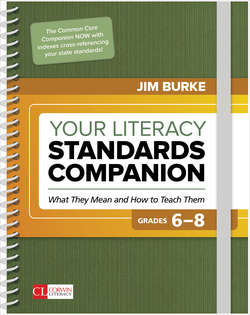Читать книгу Your Literacy Standards Companion, Grades 6-8 - Jim Burke - Страница 65
На сайте Литреса книга снята с продажи.
Common Core Reading Standard 3: What the Teacher Does
ОглавлениеTo have students analyze how complex characters develop and interact, do the following:
Have students generate a list of all the characters, and then determine, according to the criteria they create, which ones are complex and the nature of that complexity.
Have students build a plot map—individually, in groups, or as a class—noting each time certain key characters interact; analyze who does or says what, in each situation, and its effect on the text.
Have students identify the motivations of key characters and those points where their motivations conflict with other characters’ motivations; then examine what those conflicts reveal about the characters and how they affect the text as a whole.
To have students analyze how dialogue and events affect the story, do the following:
Ask students to locate specific passages or key moments in the text where complex characters do or say something that affects the plot or develops a theme; ask them to make a claim about how this element affects the text and provide textual evidence.
Create a graphic chart or plot diagram with students and ask them to analyze the plot for moments when characters do something that affects the plot—increase tension, cause change—in a measurable, discernible way. This is sometimes called a “fever chart” to represent the rising and falling action of events in the story.
To have students identify key steps in a text’s description of a process, do the following:
Provide students with a set of scrambled steps in a process or procedure, asking them to sort them based on some principle; then consider, if time allows, having them write a paragraph with appropriate transitions for each step.
Direct students’ attention to the words or other indicators that signal steps or a sequence, especially in those texts that are not arranged as a numbered list (e.g., a paragraph with transition or other signal words).
To have students analyze how an author makes connections and distinctions, do the following:
Ask students to use some sort of graphic organizer with columns for what the author connects and how (The author links A to B by doing C to show D). Do the same for distinctions, providing appropriate academic language to help students articulate these distinctions clearly (The author differentiates between A and B by pointing out C to emphasize D).
To have students analyze in detail how authors introduce, illustrate, or elaborate, do the following:
Direct students’ attention to that portion of the text that serves to introduce the idea, asking them to indicate the details of the introduction that serve this end.
Use the highlighting or color-coding features of the application to emphasize the parts of the text—whether words, typography, phrases, or whole paragraphs—that help to introduce, illustrate, or elaborate. This might mean highlighting, for example, all the signal phrases, such as for example, that indicate the writer is about to illustrate a point just made in the text.
To have students analyze how and why elements interact over the course of a text, do the following:
Have students create a timeline for the text—a list or a more graphic timeline—that shows all the events in sequence, evaluated or ranked by their importance or effect on later events.
Have students highlight or use sticky notes to identify all references to an event so students can retrace the events after reading the document to evaluate how one led to or impacted another.
Provide students a sample that shows the event, its explanations, and textual evidence, which students must learn to evaluate by identifying the most fitting explanations and evidence. Then have them find the next event, its explanation, and evidence so they show they can do this independently.
To help your English Language Learners, try this:
Evaluate the language used in the text and any directions for the assignment, and when discussing the assignment in class, find ways you could make the assignment more accessible.
